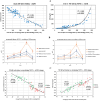Meal-Induced NF-kB Activation in Mononuclear Cells Triggers Lumican Secretion and Promotes Chronic Kidney Disease in Metabolic Dysfunction-Associated Steatotic Liver Disease
- PMID: 40787070
- PMCID: PMC12331869
- DOI: 10.1002/mco2.70122
Meal-Induced NF-kB Activation in Mononuclear Cells Triggers Lumican Secretion and Promotes Chronic Kidney Disease in Metabolic Dysfunction-Associated Steatotic Liver Disease
Conflict of interest statement
Giovanni Musso: no present or past financial or non‐financial competing interest to disclose. Filippo Mariano: no present or past financial or non‐financial competing interest to disclose. Mella Alberto: no present or past financial or non‐financial competing interest to disclose. Silvia Pinach: no present or past financial or non‐financial competing interest to disclose. Roberto Gambino: no present or past financial or non‐financial competing interest to disclose.
Figures

Similar articles
-
Hepatocellular CMPK2 promotes the development of metabolic dysfunction-associated steatohepatitis.J Hepatol. 2025 Aug;83(2):383-396. doi: 10.1016/j.jhep.2025.01.008. Epub 2025 Jan 22. J Hepatol. 2025. PMID: 39855350
-
The Effect of Mobile Lifestyle Intervention Combined with High-Protein Meal Replacement on Liver Function in Patients with Metabolic Dysfunction-Associated Steatotic Liver Disease: A Pilot Randomized Controlled Trial.Nutrients. 2024 Jul 13;16(14):2254. doi: 10.3390/nu16142254. Nutrients. 2024. PMID: 39064697 Free PMC article. Clinical Trial.
-
Chronic Nanoplastic Exposure Promotes the Development and Progression of Metabolic Dysfunction-Associated Steatotic Liver Disease.Liver Int. 2025 Aug;45(8):e70224. doi: 10.1111/liv.70224. Liver Int. 2025. PMID: 40657663 Free PMC article.
-
Metabolic-dysfunction associated steatotic liver disease and atrial fibrillation: A review of pathogenesis.World J Cardiol. 2025 Jun 26;17(6):106147. doi: 10.4330/wjc.v17.i6.106147. World J Cardiol. 2025. PMID: 40575425 Free PMC article. Review.
-
Assessing the efficacy of farnesoid X receptor agonists in the management of metabolic dysfunction-associated steatotic liver disease: A systematic review and meta-analysis: Efficacy of Farnesoid X Receptor Agonists in Metabolic Dysfunction-associated Steatotic Liver Disease: Systematic Review and Meta-analysis.Clin Res Hepatol Gastroenterol. 2025 Feb;49(2):102530. doi: 10.1016/j.clinre.2025.102530. Epub 2025 Jan 11. Clin Res Hepatol Gastroenterol. 2025. PMID: 39805519
References
-
- Hofmann M. A., Schiekofer S., Kanitz M., et al., “Insufficient Glycemic Control Increases Nuclear Factor‐Kappa B Binding Activity in Peripheral Blood Mononuclear Cells Isolated From Patients With Type 1 Diabetes,” Diabetes Care 21 (1998): 1310–1316. - PubMed
-
- Musso G., Pinach S., Mariano F., et al., “Effect of Phospholipid Curcumin Meriva® on Liver Histology and Kidney Disease in Nonalcoholic Steatohepatitis a Randomized, Double‐blind, Placebo‐Controlled Trial,” Hepatology 81, no. 2 (2025): 560–575. - PubMed
Publication types
LinkOut - more resources
Full Text Sources
